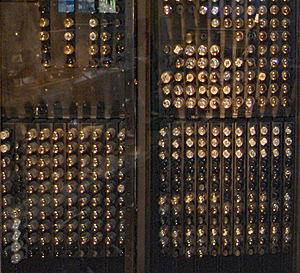

A vacuum-tube computer, now termed a first-generation computer, is a computer that uses vacuum tubes for logic circuitry. While the history of mechanical aids to computation goes back centuries, if not millennia, the history of vacuum tube computers is confined to the middle of the 20th century. Lee De Forest invented the triode in 1906. The first example of using vacuum tubes for computation, the Atanasoff–Berry computer, was demonstrated in 1939. Vacuum-tube computers were initially one-of-a-kind designs, but commercial models were introduced in the 1950s and sold in volumes ranging from single digits to thousands of units. By the early 1960s vacuum tube computers were obsolete, superseded by second-generation transistorized computers.
Much of what we now consider part of digital computing evolved during the vacuum tube era. Initially, vacuum tube computers performed the same operations as earlier mechanical computers, only at much higher speeds. Gears and mechanical relays operate in milliseconds, whereas vacuum tubes can switch in microseconds. The first departure from what was possible prior to vacuum tubes was the incorporation of large memories that could store thousands of bits of data and randomly access them at high speeds. That, in turn, allowed the storage of machine instructions in the same memory as data—the stored program concept, a breakthrough which today is a hallmark of digital computers.
Other innovations included the use of magnetic tape to store large volumes of data in compact form (UNIVAC I) and the introduction of random access secondary storage (IBM RAMAC 305), the direct ancestor of all the hard disk drives we use today. Even computer graphics began during the vacuum tube era with the IBM 740 CRT Data Recorder and the Whirlwind light pen. Programming languages originated in the vacuum tube era, including some still used today such as Fortran & Lisp (IBM 704), Algol (Z22) and COBOL. Operating systems, such as the GM-NAA I/O, also were born in this era.